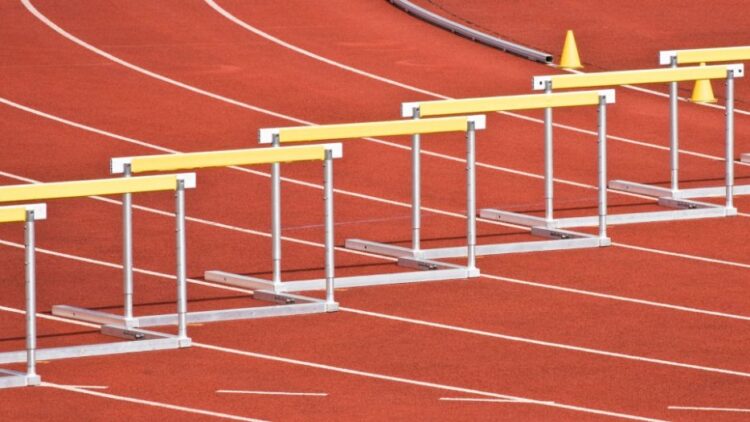
OBJECTIVE OF HURDLING: Be the first to cross the finish line in a race that involves jumping over hurdles.
NUMBER OF PLAYERS: 2+ players
MATERIALS: Running attire, hurdles
TYPE OF GAME: Sport
AUDIENCE: 11+
OVERVIEW OF HURDLING
Hurdling is a form of obstacle course racing that involves athletes racing down a track while jumping over a set number of hurdles spaced an equal distance apart. Hurdling has been a featured Olympic event since the inaugural 1896 Athens Summer Olympics.
The concept of jumping over obstacles while racing likely originated in the early- to mid-1800s. The first recorded instance of such a race can be traced back to 1837 at Eton College in England.
During the sport’s earliest days, athletes hadn’t quite developed the most efficient technique to get over the hurdle. Because of this, many early hurdlers would run up to a hurdle, set both their feet to jump, and then land on two feet. This style of hurdling required every competitor to repeatedly start and stop their momentum.
In 1885, Arthur Croome of Oxford College jumped over a hurdle with a novel technique—shooting one leg over the hurdle while using a forward torso lean. This technique allowed racers to clear the hurdles without losing much of their stride and is the basis of the technique hurdlers use today. In 1902 the first hurdle was created and called a Foster Patent Safety Hurdle, before this athletes used burgles to jump over.
Outside of the Olympic games there are several other Hurdle events such as the school races with high school and middle school athletes. There is also the Shuttle Hurdle Relay, which are relay races in which 4 teams compete in a relay style hurdle race.
SETUP

EQUIPMENT
- Running Attire: Athletes are encouraged to wear typical running attire, such as a tight-fitting shirt, shorts, and spiked track shoes.
- Hurdles: Hurdles closely resemble fences, containing a base and two upright posts that support a horizontal bar on top. These barriers are roughly four feet wide, have a minimum weight of 22 pounds, and are constructed of wood and metal. The height of a hurdle ranges from 30 to 42 inches and is dependent on the competition and event.
EVENTS
There are four hurdles events featured in the Summer Olympics. Each of these events includes ten hurdles each competitor must clear.
1) Men’s 110m Hurdles
The hurdles used for this event are 42 inches tall and placed around 10 yards apart. This event is 10 meters longer than the women’s sprint hurdling event.
2) Men’s 400m Hurdles
The hurdles used in this event are 36 inches off the ground and are spaced apart roughly 38 yards from one another.
3) Women’s 100m Hurdles
10 meters shorter than the men’s equivalent event, the women’s 100-meter hurdles event uses hurdles that are 33 inches tall and spaced roughly 9 yards apart.
4) Women’s 400m Hurdles
This event uses 30-inch-tall hurdles spaced roughly 38 yards apart (the same distance as the men’s 400m).
GAMEPLAY

SCORING
As with most racing events, all competitors are ranked according to the order in which they cross the finish line. The only exception to this is if a racer commits a violation that disqualifies them from the race.
RULES
- Similar to other track events, a runner must start out of running blocks and must not move before the starting gun. Otherwise, a false start will be called.
- A runner cannot intentionally knock a hurdle over.
- A runner cannot bypass a hurdle by moving around it in any capacity.
- A runner must stay within the lane they started the race in.
The runner is immediately disqualified if any of these rules are broken during a hurdling race.
HURDLING FORM
Using excellent hurdle technique when clearing hurdles is essential, as the goal of a hurdler is to let the hurdles impact their stride as little as possible.
The proper technique used to clear hurdles involves jumping over them in a lunge-like stance. This means:
- Driving your lead leg high into the air and straightening your trailing leg when it is above the hurdle’s height.
- While your front leg clears the hurdle, your torso and arms should be leaning as far forward and in front of you as possible.
- You must then bend and raise your trail leg knee high over the hurdle, although it is crucial to avoid slowing yourself down by raising it too high.
- As you clear the hurdle, you should start pulling your torso more upright and your arms closer to your body as you get set to resume your stride.
Check out this video, where you can see the hurdling form in action.
KNOCKING OVER HURDLES
Contrary to what someone might think, knocking over hurdles during a race carries no penalty to the offending runner. Theoretically, this means an athlete could knock down all 10 hurdles and still win the race if they’re fast enough.
That said, failing to clear a hurdle will almost always slow a runner down a considerable amount. This is because hitting the hurdle with your feet or legs will interrupt your stride and likely throw you slightly off balance. This is very evident when watching a long hurdle race, like 100- or 110-meter hurdle races, as an athlete will suddenly drop a few paces behind the pack after knocking over a hurdle.
END OF GAME
The runner who clears the last hurdle and crosses the finish line before all other competitors wins the hurdle events.
- 30 GAMES TO PLAY OVER TEXT - April 22, 2024
- 20+ FREE PRINTABLE BABY SHOWER GAMES - April 16, 2024
- 20+ College Party Games for the Best Night Ever! - April 2, 2024